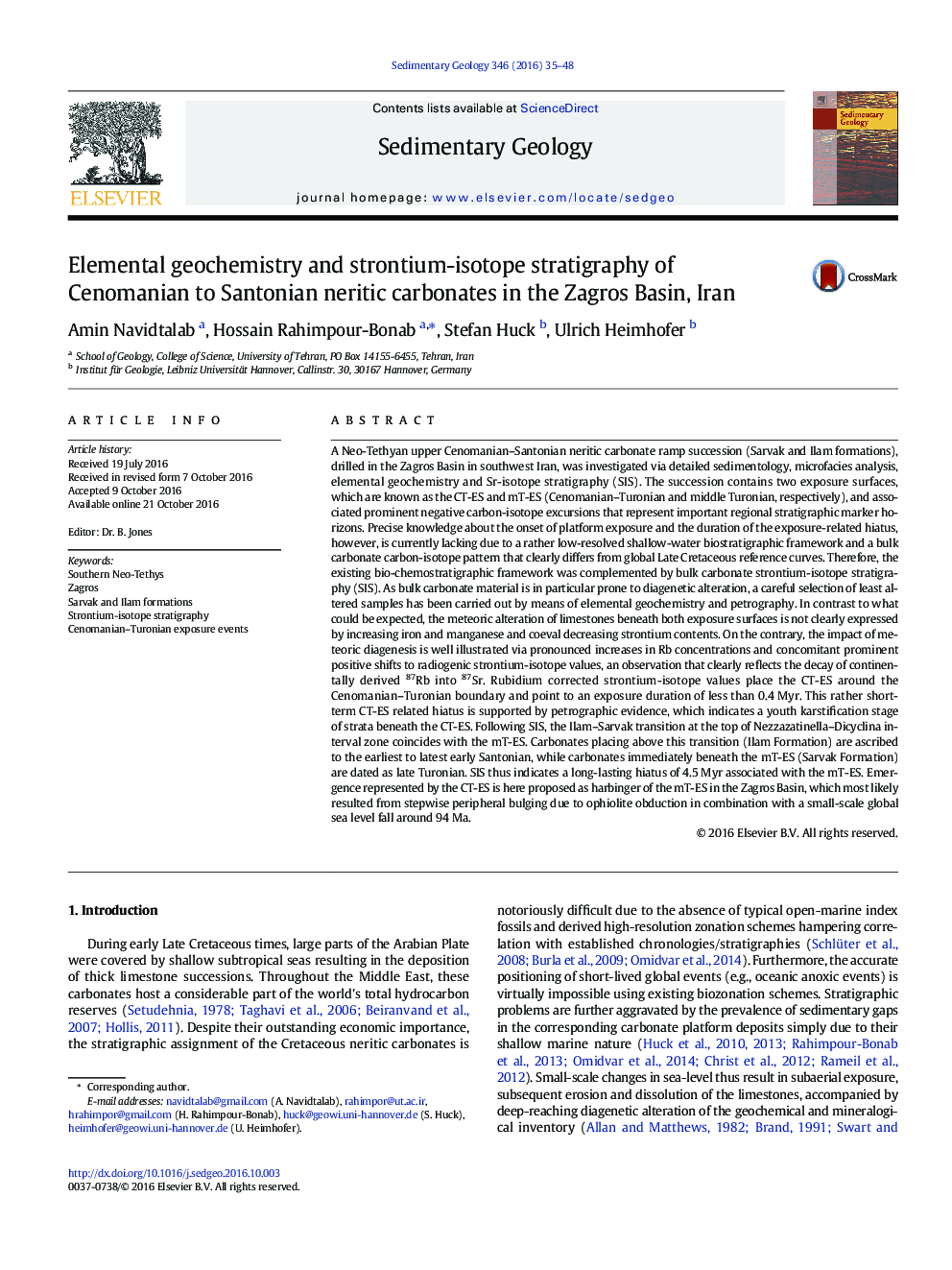| کد مقاله | کد نشریه | سال انتشار | مقاله انگلیسی | نسخه تمام متن |
|---|---|---|---|---|
| 4688889 | 1636017 | 2016 | 14 صفحه PDF | دانلود رایگان |
• Southern Neo-Tethyan Cenomanian–Campanian successions bear two disconformities.
• SIS shows 0.4 Myr hiatus for CTB exposure surface (CT-ES).
• SIS indicates 4.5 Myr hiatus for the middle Turonian exposure surface (mT-ES).
• Emergence at the CT-ES is proposed as harbinger of the mT-ES in the Zagros Basin.
• CT-ES emergence resulted from obduction combined with sea level fall around 94 Ma.
A Neo-Tethyan upper Cenomanian–Santonian neritic carbonate ramp succession (Sarvak and Ilam formations), drilled in the Zagros Basin in southwest Iran, was investigated via detailed sedimentology, microfacies analysis, elemental geochemistry and Sr-isotope stratigraphy (SIS). The succession contains two exposure surfaces, which are known as the CT-ES and mT-ES (Cenomanian–Turonian and middle Turonian, respectively), and associated prominent negative carbon-isotope excursions that represent important regional stratigraphic marker horizons. Precise knowledge about the onset of platform exposure and the duration of the exposure-related hiatus, however, is currently lacking due to a rather low-resolved shallow-water biostratigraphic framework and a bulk carbonate carbon-isotope pattern that clearly differs from global Late Cretaceous reference curves. Therefore, the existing bio-chemostratigraphic framework was complemented by bulk carbonate strontium-isotope stratigraphy (SIS). As bulk carbonate material is in particular prone to diagenetic alteration, a careful selection of least altered samples has been carried out by means of elemental geochemistry and petrography. In contrast to what could be expected, the meteoric alteration of limestones beneath both exposure surfaces is not clearly expressed by increasing iron and manganese and coeval decreasing strontium contents. On the contrary, the impact of meteoric diagenesis is well illustrated via pronounced increases in Rb concentrations and concomitant prominent positive shifts to radiogenic strontium-isotope values, an observation that clearly reflects the decay of continentally derived 87Rb into 87Sr. Rubidium corrected strontium-isotope values place the CT-ES around the Cenomanian–Turonian boundary and point to an exposure duration of less than 0.4 Myr. This rather short-term CT-ES related hiatus is supported by petrographic evidence, which indicates a youth karstification stage of strata beneath the CT-ES. Following SIS, the Ilam–Sarvak transition at the top of Nezzazatinella–Dicyclina interval zone coincides with the mT-ES. Carbonates placing above this transition (Ilam Formation) are ascribed to the earliest to latest early Santonian, while carbonates immediately beneath the mT-ES (Sarvak Formation) are dated as late Turonian. SIS thus indicates a long-lasting hiatus of 4.5 Myr associated with the mT-ES. Emergence represented by the CT-ES is here proposed as harbinger of the mT-ES in the Zagros Basin, which most likely resulted from stepwise peripheral bulging due to ophiolite obduction in combination with a small-scale global sea level fall around 94 Ma.
Figure optionsDownload high-quality image (172 K)Download as PowerPoint slide
Journal: Sedimentary Geology - Volume 346, December 2016, Pages 35–48
